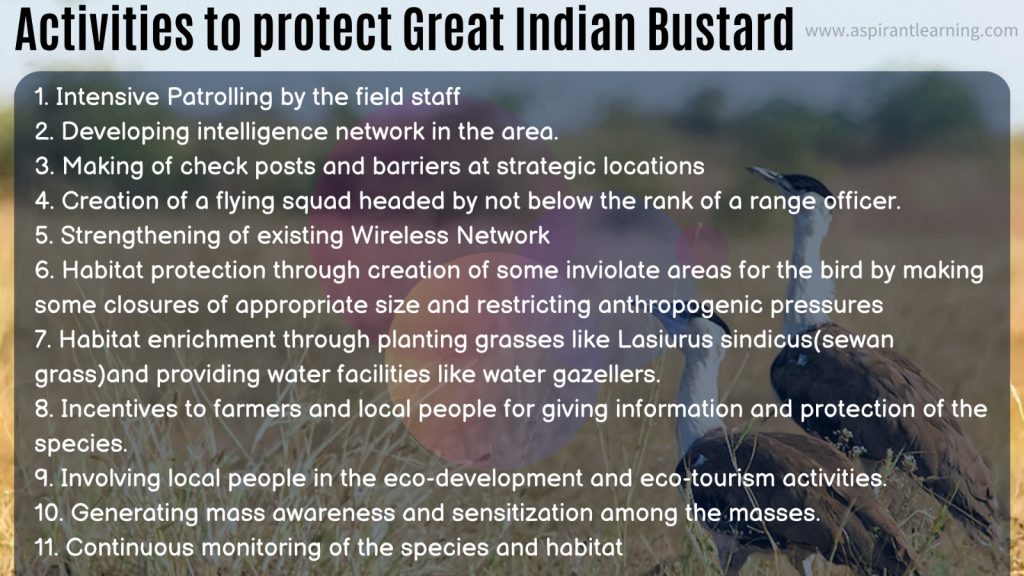News Highlights:
The Great Indian Bustard frequently crosses high-tension power lines from solar farms in Rajasthan and Gujarat, often resulting in a deadly collision.
Key Takeaway:
- The Central Electricity Authority (CEA), India’s top power regulator, has proposed that only power lines below 33 KV need to go underground and the rest be fitted with bird-diverters, a move that will benefit solar power projects in Rajasthan but may impede efforts to make the area safe for the endangered Great Indian Bustard.
- The plan has drawn criticism from environmentalists, who claim that it could result in the “extinction” of the species.
Great Indian bustard:
- About:
- The great Indian bustard (Ardeotis nigriceps), or Indian bustard, is a bustard found on the Indian subcontinent.
- It is the State bird of Rajasthan.
- It is considered the flagship grassland species, representing the health of the grassland ecology.
- Its population is confined mostly to Rajasthan and Gujarat. Small populations occur in Maharashtra, Karnataka and Andhra Pradesh.
- Once common on the dry plains of the Indian subcontinent, as few as 150 individuals were estimated to survive in 2018 (reduced from an estimated 250 individuals in 2011)
- Distribution and habitat:
- This species was formerly widespread in India and Pakistan.
- The bustard is critically endangered in Pakistan primarily due to a lack of protection and rampant hunting.
- In India, the bird was historically found in Punjab, Haryana, Uttar Pradesh, Madhya Pradesh, Chhattisgarh, Odisha, Andhra Pradesh, Rajasthan, Gujarat, Maharashtra, Karnataka and Tamil Nadu. Today the bustard is restricted to isolated pockets in Andhra Pradesh, Gujarat, Karnataka, Maharashtra, Madhya Pradesh and Rajasthan (shared with Pakistan).
- Protection Status:
- International Union for Conservation of Nature Red List (IUCN): Critically Endangered
- Convention on International Trade in Endangered Species of Wild Fauna and Flora (CITES): Appendix1
- Convention on Migratory Species (CMS): Appendix I
- Wildlife (Protection) Act, 1972: Schedule I.
Threats to GIB:
- Habitat destruction:
- The change of land use from grassland to farmland, thus shrinking the bird’s habitat.
- Degradation and disturbance in existing grassland habitat.
- Hunting:
- Lack of importance for natural grassland conservation in policy, law and Protected Area(PA) network due to an incorrect perception of ecological value vis-a-vis forests.
- Lack of protection for many ‘lekking’ and nesting sites.
- Lack of cooperation between different departments/stakeholders in GIB habitats.
- Lack of awareness and support from local communities.
- Livestock overgrazing and feral dogs.
- Disturbance by photographers:
- There is now plenty of anecdotal evidence to demonstrate that photography of the species causes substantial disturbance.
- Human disturbance may cause significant declines in animal populations.
- Disturbance from photographers in the main breeding sites was severe in the past few years.
- Infrastructure:
- The main threats to the shrinking habitat of the GIB have been industrialisation, mining, and intensive agricultural practices.
- Great Indian Bustards have been killed when they are hit with or are electrocuted by overhead cables that are meant to carry solar energy into the grid.

Measures taken to protect GIB:
- Species Recovery Programme:
- It is kept under the species recovery programme under the Integrated Development of Wildlife Habitats of the Ministry of Environment, Forests and Climate Change (MoEFCC).
- National Bustard Recovery Plans
- It is currently being implemented by conservation agencies.
- Conservation Breeding Facility
- MoEF&CC, the Rajasthan government and the Wildlife Institute of India (WII) have also established a conservation breeding facility in National Bustard Recovery Plans in June 2019.
- The objective of the programme is to build up a captive population of Great Indian Bustards and to release the chicks in the wild to increase the population.
- Project Great Indian Bustard:
- It has been launched by the Rajasthan government with an aim of constructing breeding enclosures for the species and developing infrastructure to reduce human pressure on its habitats.
- Eco-Friendly Measures:
- Task Force for suggesting eco-friendly measures to mitigate impacts of power transmission lines and other power transmission infrastructures on wildlife, including the Great Indian Bustard.
Pic Courtesy: The Hindu
Content Source: The Hindu



